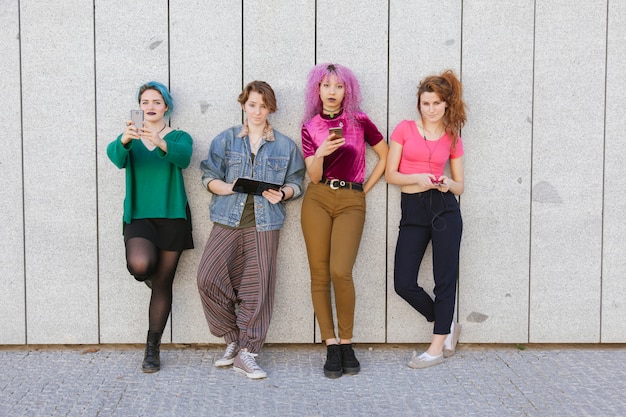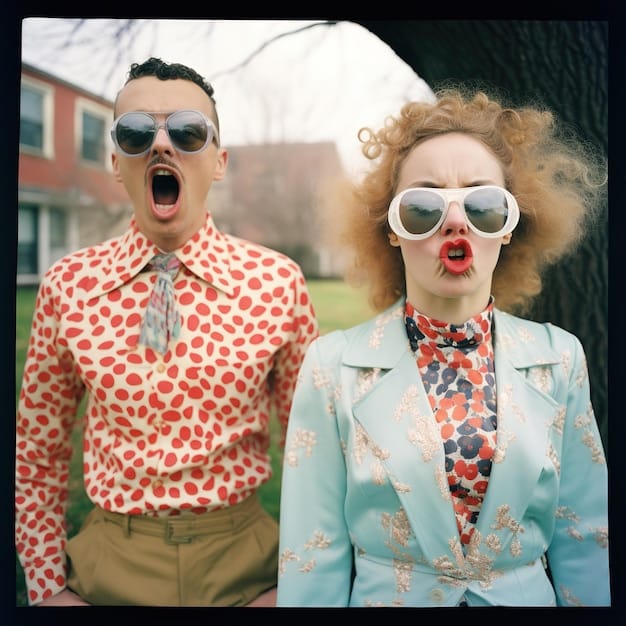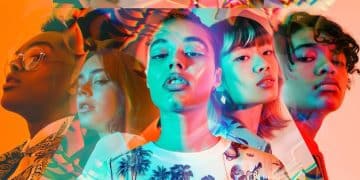The Evolution of K-Pop Fashion: A Global Domination Story

The evolution of K-Pop fashion traces its journey from coordinated debut looks to its current status as a global trendsetter, influencing everything from high fashion runways to everyday street style.
K-Pop fashion has exploded onto the global stage, captivating audiences far beyond its South Korean origins. But how did this unique style evolve from matching outfits to the influential force it is today? This article explores the evolution of K-Pop fashion: from debut to global domination.
The Genesis of K-Pop Fashion: Coordinated Beginnings
In its early days, K-Pop fashion was characterized by meticulously coordinated outfits. This uniformity was a strategic element, designed to create a strong visual identity for newly formed groups and project a sense of cohesion. Let’s delve into this foundational era.
Matching Outfits and Visual Harmony
Rookie groups strived for visual harmony through matching outfits. This approach aimed to present a united front, emphasizing the group as a single entity rather than individual members. The goal was to create a memorable and instantly recognizable image for the group, solidifying their presence in a competitive market.
Influence of Korean Street Style
While coordination was key, early K-Pop fashion also drew inspiration from emerging Korean street style trends. This fusion of uniformity with contemporary influences laid the groundwork for the genre’s future aesthetic explorations. It allowed groups to stay current while maintaining their unique visual identities.
- Early 1990s: Dominated by hip-hop influences with baggy jeans, oversized t-shirts, and baseball caps.
- Late 1990s/Early 2000s: Saw the rise of more polished and preppy styles, incorporating elements of Western fashion.
- Mid-2000s: Trends shifted towards a more eclectic and experimental mix, influenced by global pop culture.
The coordinated beginnings of K-Pop fashion set the stage for its future diversification. By focusing on visual unity, early groups established a strong foundation upon which later artists could build more complex and individualized styles.

Breaking the Mold: The Rise of Individuality
As K-Pop matured, artists began to push the boundaries of the initial coordinated aesthetic. The focus shifted from strict uniformity to showcasing individual personalities through clothing choices. This transition marked a significant turning point in the evolution of K-Pop fashion.
Experimentation with Unique Styles
Groups started experimenting with more distinct styles for each member, reflecting their personalities and roles within the group. This departure from strict uniformity allowed for greater creative expression and helped individual members stand out. This era saw the rise of stylists who acted as creative directors, crafting distinct looks for each member that still complemented the group’s overall image.
Influence of Western Pop Culture
Western pop culture played a significant role in this shift towards individuality. Artists drew inspiration from global fashion icons and trends, incorporating these influences into their personal styles. This fusion of Korean and Western elements created a unique and dynamic aesthetic.
The rise of individuality in K-Pop fashion demonstrated a growing confidence and artistic maturity within the industry. By allowing artists to express their unique personalities through clothing, groups were able to connect with their audiences on a deeper level.
The Influence of Music Video Aesthetics
Music videos have become central to shaping K-Pop fashion trends. These visually stunning productions showcase elaborate costumes and daring styles, pushing boundaries and influencing mainstream fashion. Let’s see how music videos became a fashion playground.
Evolution of Set Design Over Time
Music videos offer an elaborate canvas for showcasing cutting-edge looks. Stylists work closely with artists to create outfits that amplify the song’s message and visual narrative. From futuristic concepts to historical settings, K-Pop music videos are a playground for sartorial innovation.
Impact on High-Street Trends
The styles featured in K-Pop music videos often trickle down to high-street trends. Fans eagerly emulate their idols’ outfits, driving demand for specific items and influencing the overall fashion landscape. Music videos are therefore not only entertainment but also influential marketing tools.
- Color trends: Specific color palettes showcased in music videos can become mainstream trends.
- Accessory crazes: Unique accessories worn by idols often spark buying frenzies.
- Styling techniques: Innovative ways of combining clothing items are quickly adopted by fans.
Music videos have solidified their position as key drivers of K-Pop fashion trends. Their impact extends beyond entertainment, shaping consumer preferences and influencing the broader fashion industry.
High Fashion Meets K-Pop: Collaborations and Endorsements
K-Pop’s influence on fashion grew to such heights that it attracted high-fashion brands to collaborate with K-Pop stars. This marked a new era of recognition and integration of K-Pop into the global fashion industry.
K-Pop Stars as Brand Ambassadors
Luxury brands recognized the unique marketing potential of K-Pop artists and began enlisting them as global ambassadors. These partnerships have catapulted K-Pop stars to the forefront of the fashion world. This mutually beneficial relationship enhances the visibility of both the artists and the brands.
Red Carpet Moments and Global Exposure
K-Pop stars regularly grace international red carpets, showcasing high-fashion designs and garnering global media attention. These red carpet moments not only highlight the artists’ personal style but also serve as valuable endorsements for the brands they represent. Every appearance helps to further legitimize K-Pop artists as style icons.
The collaboration between high fashion and K-Pop has blurred the lines between music and fashion, creating a powerful cultural synergy. K-Pop’s influence on the global fashion landscape is undeniable, proving its status as a dynamic and innovative force.

The Role of Social Media in K-Pop Fashion’s Popularity
Social media platforms have significantly amplified the reach and influence of K-Pop fashion. These platforms enable artists to connect directly with fans, sharing their personal style and promoting trends. Let’s examine the role and impact of social media.
Direct Engagement with Fans
Through platforms like Instagram and Twitter, K-Pop stars offer fans a glimpse into their everyday fashion choices. This direct engagement fosters a sense of connection and allows fans to emulate their idols’ styles more easily. Every post, story, and tweet can spark a new trend.
Fashion Challenges and Viral Trends
K-Pop artists often initiate fashion challenges and viral trends on social media, encouraging fans to participate and showcase their personal interpretations of K-Pop fashion. These interactive campaigns generate significant buzz and amplify the reach of the trends. From dance challenges to outfit recreations, the possibilities are endless.
- #OOTD (Outfit Of The Day): Idols share daily outfit photos, inspiring fans to create their own looks.
- Styling Tutorials: Tutorials demonstrating how to achieve specific K-Pop-inspired hairstyles or makeup looks.
- Trend Spotting: Fans identify and promote up-and-coming trends showcased by their favorite artists.
Social media has revolutionized the way K-Pop fashion is disseminated and consumed. The direct connection between artists and fans allows for a dynamic and participatory fashion culture, perpetuating K-Pop’s global influence.
Sustainability and the Future of K-Pop Fashion
With sustainability becoming an increasingly important concern, K-Pop fashion is also starting to address environmental and ethical issues. In the future, these elements will be essential for the continued evolution and credibility.
Eco-Friendly Materials and Ethical Brands
Some K-Pop artists are beginning to advocate for eco-friendly materials and ethical brands, promoting sustainability within the fashion industry. These efforts are not only environmentally responsible, but also resonate with a growing number of conscious consumers. Showcasing eco-friendly brands helps spread awareness among fans.
Promoting Responsible Consumption
Beyond promoting eco-friendly materials, the industry has also sought to promote responsible consumption habits among fans. By advocating for quality over quantity and encouraging reuse and recycling, the artists play a part in fostering more sustainable fashion practices.
The integration of sustainability into K-Pop fashion is still in its early stages, but it holds immense potential. By aligning with environmental and ethical values, K-Pop fashion can continue to evolve and maintain its relevance in an ever-changing world.
K-Pop fashion’s journey from coordinated beginnings to its current global influence is a testament to its adaptability and creativity. As the industry embraces individuality, collaborates with high fashion, and leverages social media, its influence will only continue to grow.
| Key Point | Brief Description |
|---|---|
| 👯♀️ Coordinated Beginnings | Early K-Pop fashion emphasized matching outfits for visual unity. |
| ✨ Rise of Individuality | Artists began showcasing unique styles, reflecting personal identities. |
| 🎬 Music Video Influence | Music videos became a key platform for elaborate and trend-setting styles. |
| 🌍 Global Domination | K-Pop fashion has influenced high-fashion and street styles worldwide. |
Frequently Asked Questions
▼
K-Pop fashion started with coordinated outfits aimed at creating a strong visual identity for newly formed groups. This uniformity was a strategic element to project cohesion and memorability.
▼
As K-Pop matured, artists began pushing boundaries by showcasing individual personalities through clothing choices. This shift occurred as groups gained confidence and sought to connect more deeply with their audience.
▼
Music videos serve as a crucial platform for showcasing cutting-edge looks and daring styles. Stylists collaborate with artists to amplify the song’s message, influencing high-street fashion trends.
▼
Luxury brands recognized the marketing potential of K-Pop artists and enlisted them as global ambassadors. K-Pop stars grace international red carpets, garnering global media attention and endorsing high-fashion designs.
▼
Sustainability is becoming increasingly important. Some artists advocate for eco-friendly materials and promote responsible consumption, aiming to align K-Pop fashion with environmental and ethical values for continued relevance.
Conclusion
From coordinated outfits to global fashion collaborations, the evolution of K-Pop fashion highlights its dynamic and transformative influence. By embracing individuality, leveraging social media, and integrating sustainability, K-Pop continues to shape the global fashion landscape.





